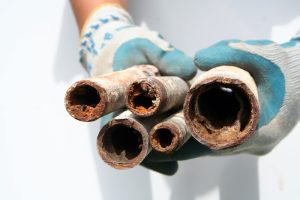The thought of repiping might make you feel nervous or overwhelmed. How could you possibly replace the plumbing pipes in your kitchen or bathroom, or in your whole house? But today’s plumbers can do it in a surprisingly smooth and straightforward way, and it’s certainly better than allowing your pipes to fall apart due to corrosion, rust, and age.
Are your pipes at risk of leaks and breaks? Could you suddenly end up with a very big plumbing emergency on your hands when something old or badly rusted falls apart? Do you need to consider repiping some or all of your home? Let’s consider plumbing materials, how they age, and how a plumber can assess the condition of your pipes.
Plumbing Materials Have Changed
The ancient Chinese made water pipes of reeds and sewer pipes of terra cotta clay. Romans used a lot of lead in their piping. Before either of these cultures were experimenting with plumbing materials, in Egypt and India, people were using copper, which remains one of the best plumbing materials to this day.
But what about more recent plumbing history? After all, your house wasn’t built in ancient Rome. But, like the Romans, you may be at risk of lead contamination! Lead pipes were banned from being used in new plumbing in 1974, but it wasn’t until 1986 that lead solder was banned from being used to connect pipes in plumbing systems. So if your house is older than that, you might still have lead in there!
Sewer lines, like those in China, were made of clay piping until surprisingly recently. It wasn’t until the 1970s that PVC pipes became the standard for the pipes that carry our wastewater from all of our drains to the municipal sewer line or your sewage tank.
The other material that has been used a great deal, in both water lines and sewer lines, is cast iron. As recently as the 1970s, these were common, and if you’ve ever seen an old iron gate or mistreated an iron frying pan, you know exactly how vulnerable this material is to corrosion.
Modern Mistakes
Although innovations have, overall, moved toward better and longer-lasting plumbing materials, there have been some unfortunate problems, too! Kitec piping was a plastic alternative that was popular in the late 90s and early 2000s, but it turned out to be much less durable than hoped. It was recalled in 2007, so if you have any in your home, it should be removed before it starts to leak.
Copper’s Durability
While PVC and PEC plastic pipes are used a lot, copper still is, too. It can be quite durable when treated with caution, but it can also be corroded if exposed to certain substances. If you’re not sure what condition your copper pipes are in—or if you don’t know what materials your plumbing system contains—you should schedule video pipe inspection, so a qualified plumber can look directly into your pipes.
Be Gentle to Your Pipes
One of the things that contributes most severely to corroded plumbing is liquid drain cleaner. These chemical solutions are so caustic that they’re dangerous to not only your hands, eyes, and respiratory passages, but also to your pipes! Instead of using these products, get professional drain cleaning in Glenview, IL.
For expert plumbing service, contact Reliance Plumbing Sewer & Drainage, Inc. Our knowledgeable plumbers serve the North Shore and Northwest Chicago suburbs. Rely on Reliance!

